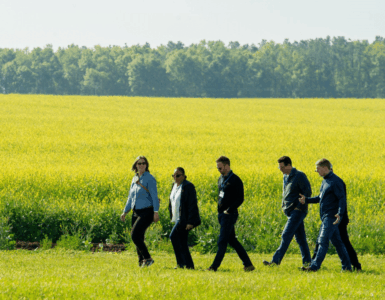Ever wondered where your t-shirt, jeans, bed sheets or socks come from?
Chances are, that a large percentage of your wardrobe is made up of Australian cotton.
In fact, in an average year, Australian cotton growers produce enough cotton to clothe 500 million people.
We’ve collated 5 interesting facts about Australian cotton. Keep reading to find out more!

- Cotton is both a food and fibre crop
Cotton is a natural fibre that grows on a plant and is both a food and fibre crop.
Known for its versatility, performance and natural comfort, cotton’s strength and absorbency make it an ideal fabric to make clothes and homewares.
But the list doesn’t stop there…cotton is also used for a range of other, more industrial products, such as tents, hotel sheets, army uniforms and even the inflight space suits astronauts wear.
It is able to be woven or knitted into fabrics including velvet, corduroy, chambray, velour, jersey and flannel and can be blended with other natural fibres such as wool or syntenic fibres like polyester.
The cotton lint from one 227kg bale can produce 215 pairs of denim jeans, 250 single bed sheets, 750 shirts, 1,200 t-shirts, 3,000 nappies, 4,300 pairs of socks, 680,000 cotton balls, or 2,100 pairs of boxer shorts.

On the other hand cotton seed, which makes up around half the weight of the picked cotton, is fed to cattle and crushed to make oil. One tonne of cotton seed yields approximately 200kg of oil, 500kg of cotton seed meal and 300kg of hulls.
Cottonseed oil is cholesterol free, high in polyunsaturated fats and contains high levels of anti-oxidants (vitamin E), which contribute to its long shelf life. This cotton seed oil is used for cooking and in products like soap, margarine, emulsifiers, cosmetics, pharmaceuticals, rubber and plastics.
The by-product of the oil-extraction process is meal, which is used as stock feed. Cotton seed meal is a high protein meal that can be fed to most animals. Cotton seed hulls are also a valuable feed source for livestock.

2. Australian cotton is grown in over 100 regions
Cotton is grown in more than 100 Australian communities. Major cotton production areas include the Central Highlands, Darling Downs, Border Rivers, St George, Mungindi and Dirranbandi regions of Queensland, and the Gwydir, Namoi, Macquarie, Murrumbidgee, Murray and Lachlan valleys of New South Wales.
Smaller amounts of cotton is grown in northern Victoria, and cotton trials are underway in northern Queensland, northern Western Australia and the Northern Territory.
There are up to 1,500 cotton farms in Australia, growing some of the finest quality and highest yielding cotton in the world. About 90% of Australia’s cotton businesses are family farms.

3. Cotton is planted in spring, over the summer period
Cotton seeds are planted in spring and the plant grows into green, bushy shrubs about one metre in height.
The plants briefly grow pink and cream coloured flowers that, once pollinated, drop off and are replaced with fruit, better known as cotton bolls.
Inside the cotton boll is fluffy, white lint as well as cotton seeds.
Once the plant has been defoliated (sprayed so the leaves die and the plant is left looking like a collection of bare sticks), and the bolls have cracked open to reveal the lint, the cotton is ready to be picked.

4. Australian cotton growers are some of the world’s most water efficient
Cotton’s average irrigation requirement is 6-7 megalitres per hectare (ML/ha) (source: Crop and Pasture Science 2013). This compares to the average water use of rice (11.5ML/ha), fruit and nut trees (5.1 ML/ha) and vegetables for human consumption (4 ML/ha) (source: ABARES).
Australian cotton has the reputation as being the most water efficient cotton industry in the world, thanks to biotechnology and advances in precision irrigation and timing.
Long-term monitoring shows the cotton industry’s significant improvements in water efficiency over time. Water-use productivity by Australian cotton growers improved by 48% since 1992.

5. Australian cotton farms are home to hundreds of species of plants and animals
Protecting natural resources and growing crops to clothe the world is a balancing act that cotton growers manage every day. Soil, water, plants, animals and air are all part of what makes a dynamic and healthy cotton farming system.
As custodians of large blocks of land, cotton growers play a role in managing Australia’s natural resources and environment. For example, cotton growers boost their water use efficiency, improve soil health, fence off remnant vegetation, practice no-till farming and Integrated Pest Management, and strive to become more efficient across the farming operation.
Industry research shows that natural areas on cotton farms, such as native vegetation and riparian zones, range between 10 – 40% of property area, and is dominated by riparian lands.
In 2019, 50% of growers had actively encouraged natural regeneration in the past year and 70% undertook weed control of natural areas.
More than 55 species of waterbirds have been recorded on farm water storages within the Namoi & Gwydir valleys in NSW. A total of 153 bird species have been found in natural vegetation in the Namoi Valley, and 450 species of invertebrates were recorded in one cotton field during the summer.
For more facts about Australian cotton, visit Cotton Australia







































Add comment